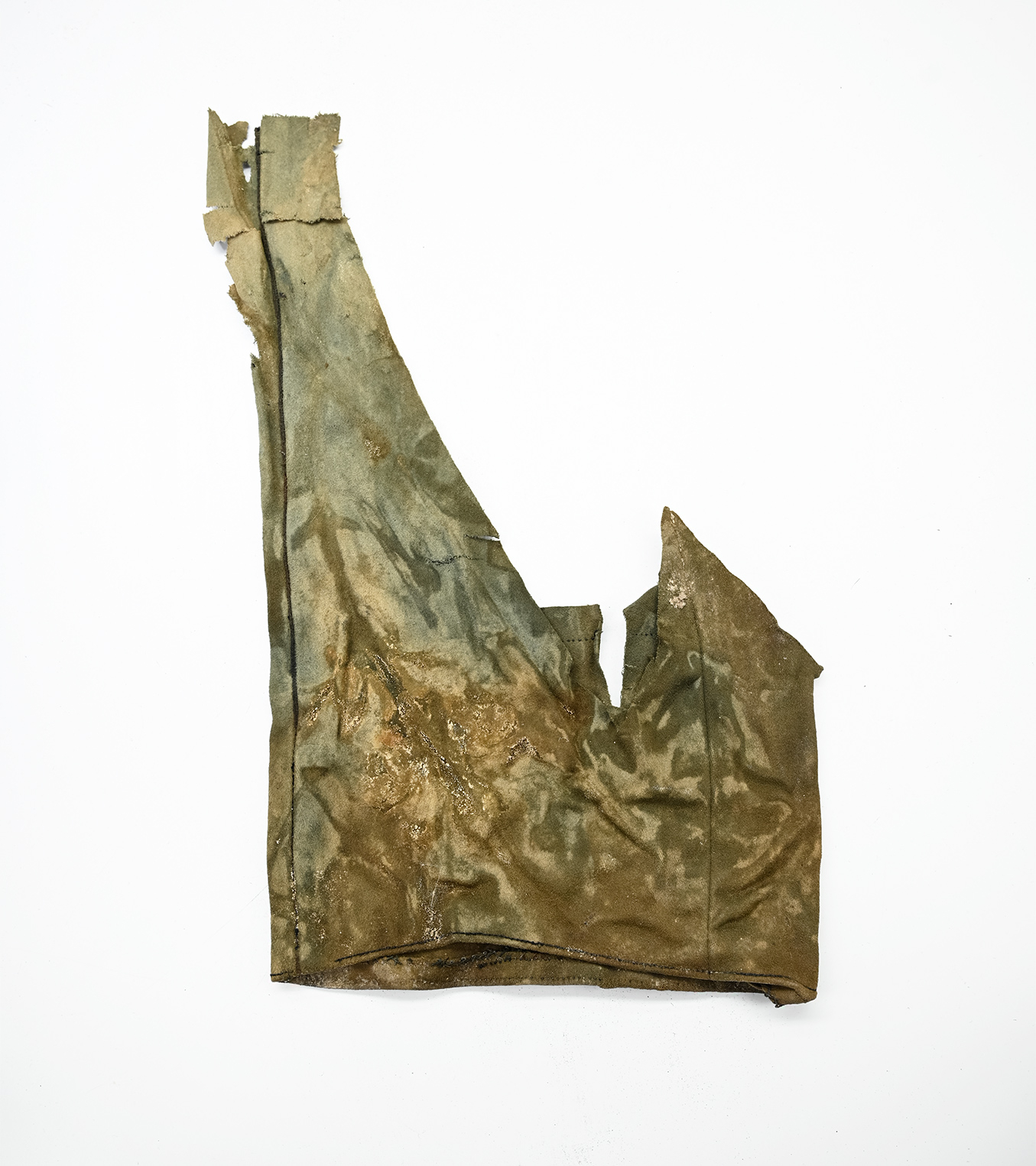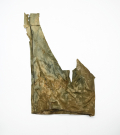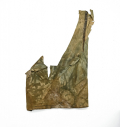site search
online catalog
TROUSER LEG FROM FORT PEMBINA, ND

$225.00
Quantity Available: 1
Item Code: 1052-563
Shipping: Determined by Method & Location of buyer
To Order:
Call 717-334-0347,
Fax 717-334-5016, or E-mail
This is the lower portion of trouser leg with the cuff intact and the fabric just above it showing tears, etc. The color has shifted from what was likely an army light blue to a mottled green and brown, giving it a rather camouflage look. This comes from the excavations a Fort Pembina, ND, where the wet, anaerobic conditions of the dig have yielded leather and cloth in remarkable states of preservation.
This was recovered on private property with the owner’s permission and was likely discarded by a soldier after salvaging pieces for other purposes. The only unusual thing about it is a different color fabric welted into not only the outer seam, but the inner seam of the leg also, which rather counts against it being a narrow officer’s stripe. The only thing we can come up with to explain it is the cloth of the welt was originally the same shade as the leg material, but the different dyes reacted differently to the soil and it was perhaps used to reinforce or decorate the seam of better quality, privately purchased trousers rather than being an indication of rank.
Situated in the Red River Valley in North Dakota near the Canadian border, Fort Pembina was established in 1870 and in operation until 1895. Trading posts existed earlier in the area as part of the fur trade, and the first U.S. military post there was temporary- manned by a detachment of Minnesota troops in 1863-1864 following the 1862 Sioux uprising. In March 1870 a new fort was established south of the Pembina River and about 200 yards west of the Red River, completed by July and named in honor of Gen. George H. Thomas. The name was changed to Fort Pembina in September and the initial garrison consisted of two companies of the 20th US Infantry. Their main duty was to provide security for settlers worried about Sioux returning south from Canada, but the troops were more occupied with escorting boundary surveys along the Canadian border and preventing Fenian raids heading north into Canada.
The fort included enlistedmen’s barracks, officers’ quarters, guard house, ordnance storehouse, company kitchen, root house, laundress’s quarters, quarters for civilian employees, hospital and hospital servant’s house, a barn for the “hospital cow,” quartermaster and commissary offices and storehouse, stables, wagon shed, etc. The garrison reached peak strength in 1878 af 200, but the average was about 125 enlisted men and 8 officers. An October 1885 return listed 97 men, 2 field pieces, 1 mountain howitzer, 100 rifles, 19 pistols, 23 mules, and 9 wagons. By 1890 the post had just 23 men, and after an 1895 fire destroyed some 19 buildings it was decided to abandon the fort rather than rebuild, the last detachment left in September. The property was turned over to the Interior Department and later sold in 1902.
Excavations at the site have yielded a trove of material casting light on the material culture of the fort’s garrison, who were equipped with Civil War material well into the 1870s and then later patterns as they were adopted and became available for issue, along with various privately purchased clothing. This is in good condition for an excavated piece, displayable, and has a tight provenance to an Indian War post garrisoned by the U.S. army for a well-defined period that encompasses the 1870s and 1880s Indian Wars. [sr] [ph:m]
~~~~~~~~~~~~~~~~~~~~~~~~~~~~~~~~~~~
THIS ITEM, AS WITH ALL OTHER ITEMS AVAILABLE ON OUR WEB SITE,
MAY BE PURCHASED THROUGH OUR LAYAWAY PROGRAM.
CLICK HERE FOR OUR POLICIES AND TERMS.
THANK YOU!
Inquire About TROUSER LEG FROM FORT PEMBINA, ND
For inquiries, please email us at [email protected]
Most Popular
Historical Firearms Stolen From The National Civil War Museum In Harrisburg, Pa »
Theft From Gravesite Of Gen. John Reynolds »
Cavalry Carbine Sling Swivel »
Fine Condition Brass Infantry Bugle Insignia »
featured item
CONFEDERATE GENERAL LUNSFORD LINDSAY LOMAX AS A WEST POINT CADET IN DAGUERREOTYPE BY ANSON CA. 1854/55, EX-BILL TURNER COLLECTION
Formerly in the collection of Virginia collector and dealer Bill Turner this ninth plate cased daguerreotype by Rufus Anson of New York City is extremely clear, nicely cased, has a mat showing the photographer’s name and address, and shows later… (1138-1905). Learn More »




